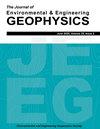Rayleigh Wave Dispersion Curve Inversion with the Artificial Bee Colony Algorithm
IF 0.7
4区 工程技术
Q4 ENGINEERING, GEOLOGICAL
引用次数: 1
Abstract
Rayleigh wave dispersion curve inversion is a non-linear iterative optimization process with multi-parameter and multi-extrema. It is difficult to carry out inversion and reconstruction of stratigraphic parameters quickly and accurately with a single linear or non-linear inversion for the data processing of Rayleigh waves with complex seismic geological conditions. We proposed a new method that combines artificial bee colony algorithm (ABC) and damped least squares algorithm (DLS) to invert Rayleigh wave dispersion curve. First, food sources are initialized in a large scale of the model based on the prior geological information. Then, after three kinds of bee operators (employed bees, onlooker bees and scout bees) transform each other and perform search optimization with several iterations, the targets are converged near the optimal solution to obtain an initial S-wave velocity model. Finally, the final S-wave velocity model is obtained by local optimization of DLS inversion with fast convergence and strong stability. The correctness of the method has been verified by one high-velocity interlayer model, and it was further applied to a real Rayleigh wave dataset. The results show that our method not only absorbs the advantages of ABC global search optimization and strong adaptability, but also makes full use of the advantages of DLS inversion, such as high accuracy and fast convergence speed. The inversion strategy can effectively suppress the inversion falling into local extrema, get rid of the dependence on an initial model, enhance the inversion stability, further improve the convergence speed and inversion accuracy, while has good anti-noise ability.用人工蜂群算法反演瑞利波色散曲线
瑞利波频散曲线反演是一个多参数、多极值的非线性迭代优化过程。对于具有复杂地震地质条件的瑞利波资料处理,单次线性或非线性反演难以快速准确地进行地层参数的反演和重建。提出了一种结合人工蜂群算法(ABC)和阻尼最小二乘算法(DLS)反演瑞利波色散曲线的新方法。首先,基于先验的地质信息,在模型的大尺度上初始化食物来源。然后,通过雇佣蜂、围观者蜂和侦察兵蜂三种蜜蜂操作者相互变换,多次迭代进行搜索优化,使目标收敛到最优解附近,得到初始横波速度模型。最后,通过DLS反演的局部优化得到最终的s波速度模型,该模型收敛快,稳定性强。通过一个高速层间模型验证了该方法的正确性,并将其进一步应用于实际瑞利波数据集。结果表明,我们的方法既吸收了ABC全局搜索优化和适应性强的优点,又充分利用了DLS反演精度高、收敛速度快的优点。该反演策略能有效抑制反演陷入局部极值,摆脱对初始模型的依赖,增强反演稳定性,进一步提高收敛速度和反演精度,同时具有良好的抗噪能力。
本文章由计算机程序翻译,如有差异,请以英文原文为准。
求助全文
约1分钟内获得全文
求助全文
来源期刊

Journal of Environmental and Engineering Geophysics
地学-地球化学与地球物理
CiteScore
2.70
自引率
0.00%
发文量
13
审稿时长
6 months
期刊介绍:
The JEEG (ISSN 1083-1363) is the peer-reviewed journal of the Environmental and Engineering Geophysical Society (EEGS). JEEG welcomes manuscripts on new developments in near-surface geophysics applied to environmental, engineering, and mining issues, as well as novel near-surface geophysics case histories and descriptions of new hardware aimed at the near-surface geophysics community.
 求助内容:
求助内容: 应助结果提醒方式:
应助结果提醒方式:


